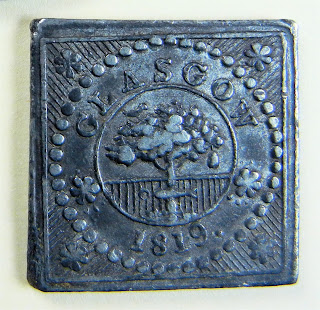Many CTs are primitive. Some are very old; others come from rural parishes where the elders had to make do. Primitive typically means handcrafted with makeshift tools. As such, they were made, one at a time, with an awkward pair of hands. As collectors, we like this.
Primitive CTs are as charming as they are mystifying. Unadorned, simple CTs are all about meeting a need: they were expedient. A token was needed, and so they were made with whatever tools were handy. Personally, I think CTs made this way have a purity all their own. And remember, the parishioners valued them for what they signified, not by what they looked like.
So how do we define primitive? A good start is to consider the small molded bits of lead with one or two letters stamped upon them. Many parishes used a simple one or two letter design in the old days, so we have many to choose from. Looking at Burzinski, we can find CTs like this starting with every letter of the alphabet -- all of them incuse of course -- except for Q, X & Z. Laid on a table, they would resemble a Scrabble set.
Most often, the letters represent the name of the parish. The first letter would suffice, but sometimes the first two letters or the first and last letters of the parish were used. But many early pieces have only the minister's initials on them. In the latter case, the minister was able to take his CTs with him when he was called elsewhere.
 |
| The CT from Bolton is primitive, but it does have two letters for the parish and a K on the reverse for the Kirk. It is a small rectangle at 14x11mm, and each one of them is different. |
This rude little rectangle has obviously been shaped by inexpert hands. Bits like this make me wonder if several of the elders made it. Just imagine: pious men cutting molds and shaping the punches for the letters. It was serious business. Each token has to be accounted for.
Did they use some implement lying at the bottom of a wheelwright's chest to make the letters? It looks as if a single circle punch was used, as the center circles (the doughnut holes, if you will) are all of similar size. But then, how did they make the upright of the B? There are many questions to ponder.
Fortunately in this case, we may have an answer. Or part of an answer. The specimen pictured came from an old collection in Scotland. The note accompanying this piece states that it was acquired from the Haddington Presbytery collection, and that it was "made by ministers."
Bolton has always been a small village, but it had a church dating back to 1240. A new church was built in 1809. It was an imposing Gothic structure designed to sit about 300 parishioners. And so we wonder: when was this primitive token used? It most likely was used in the old church, as the token is considered to be an eighteenth century piece. After all, it is included in Brook. If it is from the late 1700s, how many were made? Less than 300?
I think less. And fewer than that survived. And here I am -- an ocean away -- holding one in my palm and contemplating it. How cool is that?















